Synthesis of Alpha Ferrous Oxalate Dihydrate from Ferrotitaniferous Mineral Sands via Hot Pressurized Aqueous Oxalic Acid: Kinetics and Characterization
Abstract
1. Introduction
2. Materials and Methods
2.1. Materials
2.2. Synthesis of Ferrous Oxalate by Pressurized Aqueous Oxalic Acid
2.3. Kinetics of Ferrous Oxalate Synthesis
2.4. Characterization of As-Synthesized Ferrous Oxalate and Remnant Supernatant
2.4.1. Phase Composition and Crystallographic Structure
2.4.2. Raman Spectroscopy
2.4.3. Morphology
2.4.4. Specific Surface Area
2.4.5. Band Gap Energy
2.4.6. Iron and Titanium Contents in the Supernatant
3. Results and Discussion
3.1. Synthesis of Ferrous Oxalate by Pressurized Aqueous Oxalic Acid
3.2. Kinetics of Ferrous Oxalate Formation
3.3. Characterization of the As-Synthesized Ferrous Oxalate
3.3.1. Phase Composition and Crystallographic Structure
3.3.2. Morphology
3.3.3. Specific Surface Area and Optical Band Gap Energy
4. Conclusions
Author Contributions
Funding
Data Availability Statement
Acknowledgments
Conflicts of Interest
References
- Baran, E.J. Natural iron oxalates and their analogous synthetic counterparts: A review. Geochemistry 2016, 76, 449–460. [Google Scholar] [CrossRef]
- Echigo, T.; Kimata, M. Crystal chemistry and genesis of organic minerals: A review of oxalate and polycyclic aromatic hydrocarbon minerals. Can. Mineral. 2010, 48, 1329–1357. [Google Scholar] [CrossRef]
- Huskić, I.; Friščić, T. Geomimetic approaches in the design and synthesis of metal-organic frameworks. Philos. Trans. R. Soc. A Math. Phys. Eng. Sci. 2019, 377, 20180221. [Google Scholar] [CrossRef] [PubMed]
- Zelenskaya, M.S.; Izatulina, A.R.; Frank-Kamenetskaya, O.V.; Vlasov, D.Y. Iron oxalate humboldtine crystallization by fungus aspergillus niger. Crystals 2021, 11, 1591. [Google Scholar] [CrossRef]
- Chun, C.Z.; Lin, S.; Zhe, L.; Hua, C.S.; Xu, H.J.; Ping, L.; Liang, L.; Lin, L.J. Method for Preparing Iron Oxalate. Patent CN101717331A, 17 April 2013. [Google Scholar]
- Worsley, J.; Shrestha, A. Production of Iron (ii) Oxalate. Patent CA3215239A1, 6 October 2022. status pending. [Google Scholar]
- Zhou, J.K.; Liang, L.J.; Jun, C.H. Method for Producing Ferrous Oxalate from Hematite. Patent CN101085732A, 12 December 2007. status pending. [Google Scholar]
- Lin, B.; Yu, C.W.; Feng, X. Method for Preparing Ferrous Oxalate Hydrated Salt Crystal. Patent CN101209961B, 6 April 2006. [Google Scholar]
- Li, J.; Ting, W.; Honggang, W. Preparation of Lithium Iron Phosphate Positive Electrode Material for Lithium Ion Power Cell. Patent CN101339995A, 7 January 2009. status pending. [Google Scholar]
- Market Research Intellect. Ferrous Oxalate Market Set to Surge as Pharma and Healthcare Industries Drive Demand, Pharma and Healthcare. Available online: https://www.marketresearchintellect.com/blog/ferrous-oxalate-market-set-to-surge-as-pharma-and-healthcare-industries-drive-demand/ (accessed on 29 August 2024).
- Yao, W.; Armstrong, A.R.; Zhou, X.; Sougrati, M.T.; Kidkhunthod, P.; Tunmee, S.; Sun, C.; Sattayaporn, S.; Lightfoot, P.; Ji, B.; et al. An oxalate cathode for lithium ion batteries with combined cationic and polyanionic redox. Nat. Commun. 2019, 10, 1–9. [Google Scholar] [CrossRef]
- Keshavarz, F.; Kadek, M.; Barbiellini, B.; Bansil, A. Anodic Activity of Hydrated and Anhydrous Iron (II) Oxalate in Li-Ion Batteries. Condens. Matter 2022, 7, 8. [Google Scholar] [CrossRef]
- Zhang, K.; Liang, F.; Wang, Y.; Dai, Y.; Yao, Y. Multilayer iron oxalate with a mesoporous nanostructure as a high-performance anode material for lithium-ion batteries. J. Alloys Compd. 2019, 779, 91–99. [Google Scholar] [CrossRef]
- Zhang, K.; Li, Y.; Wang, Y.; Zhao, J.; Chen, X.; Dai, Y.; Yao, Y. Enhanced electrochemical properties of iron oxalate with more stable Li+ ions diffusion channels by controlling polymorphic structure. Chem. Eng. J. 2020, 384, 123281. [Google Scholar] [CrossRef]
- Müller, H.; Bourcet, L.; Hanfland, M. Iron(II)oxalate Dihydrate—Humboldtine: Synthesis, Spectroscopic and Structural Properties of a Versatile Precursor for High Pressure Research. Minerals 2021, 11, 113. [Google Scholar] [CrossRef]
- Dhal, J.P.; Mishra, B.G.; Hota, G. Ferrous oxalate, maghemite and hematite nanorods as efficient adsorbents for decontamination of Congo red dye from aqueous system. Int. J. Environ. Sci. Technol. 2015, 12, 1845–1856. [Google Scholar] [CrossRef]
- Yang, X.; Zhang, H.; Liu, Y.; Ning, W.; Han, W.; Liu, H.; Huo, C. Preparation of iron carbides formed by iron oxalate carburization for Fischer–Tropsch synthesis. Catalysts 2019, 9, 347. [Google Scholar] [CrossRef]
- Galeas, S.; Valdivieso-Ramírez, C.S.; Pontón, P.I.; Goetz, V.; Guerrero, V.H. Photocatalytic activity of Fe/Ti-based compounds obtained from ferro-titaniferous mineral sands via a simple soft chemistry route. J. Phys. Conf. Ser. 2022, 2238, 012006. [Google Scholar] [CrossRef]
- Wang, G.; Zhou, A.; Xu, Q. α-Ferrous oxalate with different micro scale: Synthesis and catalytic degradation effect to rhodamine B. Solid State Sci. 2019, 91, 54–60. [Google Scholar] [CrossRef]
- Fan, X.; Zhang, L.; Li, M.; Wang, M.; Zhou, X.; Cheng, R.; Zhou, Y.; Shi, J. α-Ferrous oxalate dihydrate: A simple coordination polymer featuring photocatalytic and photo-initiated Fenton oxidations. Sci. China Mater. 2016, 59, 574–580. [Google Scholar] [CrossRef]
- Li, K.; Liang, Y.; Yang, J.; Yang, G.; Xu, R.; Xie, X. α-Ferrous oxalate dihydrate: An Fe-based one-dimensional metal organic framework with extraordinary photocatalytic and Fenton activities. Catal. Sci. Technol. 2018, 8, 6057–6061. [Google Scholar] [CrossRef]
- Tu, H.; Zhang, W.; Fu, L.; Huang, Z.; Zhou, X.; Deng, L.; Liao, M.; Yang, S.; Chen, S.; Wang, H.; et al. Ferrous-oxalate-modified aramid nanofibers heterogeneous Fenton catalyst for methylene blue degradation. Polymers 2022, 14, 3491. [Google Scholar] [CrossRef]
- Hu, L.; Liu, Z.; He, C.; Wang, P.; Chen, S.; Xu, J.; Wu, J.; Wang, L.; Wang, H. Ferrous-oxalate-decorated polyphenylene sulfide fenton catalytic microfiber for methylene blue degradation. Compos. Part B Eng. 2019, 176, 107220. [Google Scholar] [CrossRef]
- Li, F.B.; Li, X.Z.; Li, X.M.; Liu, T.X.; Dong, J. Heterogeneous photodegradation of bisphenol A with iron oxides and oxalate in aqueous solution. J. Colloid Interface Sci. 2007, 311, 481–490. [Google Scholar] [CrossRef]
- Wu, S.; Wang, Y.; Jia, Q.; Gu, L.; Sun, Y. Synthesis of FeC2O4-graphene composites and their application in removal dyes. Adv. Mater. Res. 2012, 463, 533–537. [Google Scholar] [CrossRef]
- Huang, M.; Zhou, T.; Wu, X.; Mao, J. Distinguishing homogeneous-heterogeneous degradation of norfloxacin in a photochemical Fenton-like system (Fe3O4/UV/oxalate) and the interfacial reaction mechanism. Water Res. 2017, 119, 47–56. [Google Scholar] [CrossRef]
- Li, P.; Du, Y.; Li, L.; Huang, L.; Rudolph, V.; Nguyen, A.V.; Xu, Z.P. Preparation and characterisation of manganese and iron compounds as potential control-release foliar fertilisers. Biointerface Res. Appl. Chem. 2014, 4, 746–753. [Google Scholar]
- Anstoetz, M.; Rose, T.J.; Clark, M.W.; Yee, L.H.; Raymond, C.A.; Vancov, T. Novel applications for oxalate-phosphate-amine metal-organic-frameworks (OPA-MOFs): Can an iron-based OPA-MOF be used as slow-release fertilizer? PLoS ONE 2015, 10, eo144169. [Google Scholar] [CrossRef]
- Lee, S.I.; Kim, H.R.; Park, J.K.; Oh, W.; Kim, J.; Kim, C.; Lee, J.; Kim, K.C.; Lee, B.C. Precipitation of Ferrous Oxalate from Ferrous Ammonium Sulfate in Oxalic Acid Solution. Processes 2022, 10, 2420. [Google Scholar] [CrossRef]
- Valdivieso-Ramírez, C.S.; Pontón, P.I.; Dosen, A.; Marinkovic, B.A.; Guerrero, V.H. One-Step Synthesis of Iron and Titanium-Based Compounds Using Black Mineral Sands and Oxalic Acid under Subcritical Water Conditions. Minerals 2022, 12, 306. [Google Scholar] [CrossRef]
- Lagos, K.J.; Marinkovic, B.A.; Debut, A.; Vizuete, K.; Guerrero, V.H.; Pardo, E.; Pontón, P.I. Towards iron-titanium oxide nanostructures from ecuadorian black mineral sands. Minerals 2021, 11, 122. [Google Scholar] [CrossRef]
- Doebelin, N.; Kleeberg, R. Profex: A graphical user interface for the Rietveld refinement program BGMN. J. Appl. Crystallogr. 2015, 48, 1573–1580. [Google Scholar] [CrossRef]
- Makuła, P.; Pacia, M.; Macyk, W. How To Correctly Determine the Band Gap Energy of Modified Semiconductor Photocatalysts Based on UV-Vis Spectra. J. Phys. Chem. Lett. 2018, 9, 6814–6817. [Google Scholar] [CrossRef]
- He, G.; Bhamidi, V.; Tan, R.B.H.; Kenis, P.J.A.; Zukoski, C.F. Determination of critical supersaturation from microdroplet evaporation experiments. Cryst. Growth Des. 2006, 6, 1175–1180. [Google Scholar] [CrossRef]
- Laufersky, G.; Nann, T. Physical chemistry of nanoparticle syntheses. Compr. Nanosci. Nanotechnol. 2019, 1–5, 1–16. [Google Scholar] [CrossRef]
- Nývlt, J. Kinetics of nucleation in solutions. J. Cryst. Growth 1968, 3–4, 377–383. [Google Scholar] [CrossRef]
- Li, C.; Ning, Y.; Yan, T.; Zheng, W. Studies on nucleation and crystal growth kinetics of ferrous oxalate. Heliyon 2019, 5, e02758. [Google Scholar] [CrossRef] [PubMed]
- Doran, P.M. Unit Operations. In Bioprocess Engineering Principles, 2nd ed.; Academic Press: Cambridge, MA, USA, 2013; pp. 445–595. [Google Scholar] [CrossRef]
- Moldoveanu, S.C. Pyrolysis of carboxylic acids. In Pyrolysis of Organic Molecules, 2nd ed.; Elsevier Science: Amsterdam, The Netherlands, 2019; pp. 483–553. [Google Scholar] [CrossRef]
- van Eldik, R.; Klärner, F.G. High Pressure Chemistry: Synthetic, Mechanistic, and Supercritical Applications; Wiley-VCH: Weinheim, Germany, 2007; pp. 1–458. [Google Scholar] [CrossRef]
- Chen, B.; Hoffmann, R.; Cammi, R. The Effect of Pressure on Organic Reactions in Fluids—A New Theoretical Perspective. Angew. Chem. Int. Ed. 2017, 56, 11126–11142. [Google Scholar] [CrossRef]
- Eldik, R.V.; Asano, T.; Le Noble, W.J. Activation and Reaction Volumes in Solution. 2. Chem. Rev. 1989, 89, 549–688. [Google Scholar] [CrossRef]
- Shih, K.-Y.; Burlica, R.; Finney, W.C.; Locke, B.R. Effect of Pressure on Chemical Reaction in a Liquid Phase Electrical Discharge Reactor. In Proceedings of the 2007 IEEE Industry Applications Annual Meeting, New Orleans, LA, USA, 23–27 September 2008; pp. 1124–1128. [Google Scholar] [CrossRef]
- Serment-Moreno, V.; Deng, K.; Wu, X.; Welti-Chanes, J.; Velazquez, G.; Antonio Torres, J. Pressure Effects on the Rate of Chemical Reactions Under the High Pressure and High Temperature Conditions Used in Pressure-Assisted Thermal Processing. In Handbook of Food Chemistry; Springer: Berlin/Heidelberg, Germany, 2015; pp. 937–964. [Google Scholar] [CrossRef]
- Martinez-Monteagudo, S.I.; Saldaña, M.D. Chemical reactions in food systems at high hydrostatic pressure. Food Eng. Rev. 2014, 6, 105–126. [Google Scholar] [CrossRef]
- Lagos, K.J.; Marinkovic, B.A.; Dosen, A.; Debut, A.; Vizuete, K.; Guerrero, V.H.; Pardo, E.; Pontón, P.I. KOH-Based Hydrothermal Synthesis of Iron-Rich Titanate Nanosheets Assembled into 3D Hierarchical Architectures from Natural Ilmenite Mineral Sands. Minerals 2023, 13, 406. [Google Scholar] [CrossRef]
- Taxiarchou, M.; Panias, D.; Douni, I.; Paspaliaris, I.; Kontopoulos, A. Dissolution of hematite in acidic oxalate solutions. Hydrometallurgy 1997, 44, 287–299. [Google Scholar] [CrossRef]
- Inglezakis, V.J.; Zorpas, A.A. Heat of adsorption, adsorption energy and activation energy in adsorption and ion exchange systems. Desalination Water Treat. 2012, 39, 149–157. [Google Scholar] [CrossRef]
- Valdivieso-Ramírez, C.S.; Sanchez, J.-E.; Ganzle, M.; Temelli, F.; Saldaña, M.D.A. Carboxylic acid-catalized hydrolysis of polygalcturonic acid in subcritical water media. J. Supercrit. Fluids 2021, 169, 1–9. [Google Scholar] [CrossRef]
- Lu, Y.; Mosier, N.S. Biomimetic catalysis for hemicellulose hydrolysis in corn stover. Biotechnol. Prog. 2007, 23, 116–123. [Google Scholar] [CrossRef]
- Kharkar, D.P.; Patel, C.C. Oxalates of titanium. J. Indian Inst. Sci. 1957, 39, 41. [Google Scholar]
- Van de Velde, G.M.H. The oxalato complexes of titanium(IV)—I: Mononuclear Ti(OH)2(C2O4)22− in solution. J. Inorg. Nucl. Chem. 1977, 39, 1357–1362. [Google Scholar] [CrossRef]
- Kakihana, M.; Kobayashi, M.; Tomita, K.; Petrykin, V. Application of water-soluble titanium complexes as precursors for synthesis of titanium-containing oxides via aqueous solution processes. Bull. Chem. Soc. Jpn. 2010, 83, 1285–1308. [Google Scholar] [CrossRef]
- Tomita, K.; Petrykin, V.; Kobayashi, M.; Shiro, M.; Yoshimura, M.; Kakihana, M. A water-soluble titanium complex for the selective synthesis of nanocrystalline brookite, rutile, and anatase by a hydrothermal method. Angew. Chem. Int. Ed. 2006, 45, 2378–2381. [Google Scholar] [CrossRef] [PubMed]
- Frank, O.; Zukalova, M.; Laskova, B.; Kürti, J.; Koltai, J.; Kavan, L. Raman spectra of titanium dioxide (anatase, rutile) with identified oxygen isotopes (16, 17, 18). Phys. Chem. Chem. Phys. 2012, 14, 14567–14572. [Google Scholar] [CrossRef]
- Kernazhitsky, L.; Shymanovska, V.; Gavrilko, T.; Naumov, V.; Fedorenko, L.; Kshnyakin, V.; Baran, J. Laser-excited excitonic luminescence of nanocrystalline TiO2 powder. Ukr. J. Phys. 2014, 59, 246. [Google Scholar] [CrossRef]
- Bansal, J.; Tabassum, R.; Swami, S.K.; Bishnoi, S.; Vashishtha, P.; Gupta, G.; Sharma, S.N.; Hafiz, A.K. Performance analysis of anomalous photocatalytic activity of Cr-doped TiO2 nanoparticles [Cr(x)TiO2(1−x)]. Appl. Phys. A 2020, 126, 1–10. [Google Scholar] [CrossRef]
- Tuschel, D. Raman Spectroscopy and Polymorphism; MJH Life Sciences: Cranbury, NJ, USA, 2019; Volume 34. [Google Scholar]
- Gupta, A.K.; Aula, M.; Pihlasalo, J.; Mäkelä, P.; Huttula, M.; Fabritius, T. Preparation of synthetic titania slag relevant to the industrial smelting process using an induction Furnace. Appl. Sci. 2021, 11, 1153. [Google Scholar] [CrossRef]
- Ogasawara, H.; Koga, N. Kinetic modeling for thermal dehydration of ferrous oxalate dihydrate polymorphs: A combined model for induction period-surface reaction-phase boundary reaction. J. Phys. Chem. A 2014, 118, 2401–2412. [Google Scholar] [CrossRef]
- Prywer, J. Kinetic and geometric determination of the growth morphology of bulk crystals: Recent developments. Prog. Cryst. Growth Charact. Mater. 2005, 50, 1–38. [Google Scholar] [CrossRef]
- Pouget, E.M.; Bomans, P.H.H.; Dey, A.; Frederik, P.M.; De With, G.; Sommerdijk, N.A.J.M. The development of morphology and structure in hexagonal vaterite. J. Am. Chem. Soc. 2010, 132, 11560–11565. [Google Scholar] [CrossRef]
- Sing, K.S.W.; Everett, D.H.; Haul, R.A.W.; Moscou, L.; Pierotti, R.A.; Rouquerol, J.; Siemieniewska, T. Reporting physisorption data for gas/solid systems with special reference to the determination of surface area and porosity. Pure Appl. Chem. 1985, 57, 603–619. [Google Scholar] [CrossRef]
- Khan, D.; Qiu, L.; Liang, C.; Mirza, K.; Kashif, M.; Yang, B.; Kra, K.L.; Wang, Y.; Li, X. Formation and distribution of different pore types in the lacustrine calcareous shale: Insights from XRD, FE-SEM, and low-pressure nitrogen adsorption analyses. ACS Omega 2022, 7, 10820–10839. [Google Scholar] [CrossRef] [PubMed]
- Xu, L.; Zhang, J.; Ding, J.; Liu, T.; Shi, G.; Li, X.; Dang, W.; Cheng, Y.; Guo, R. Pore structure and fractal characteristics of different shale lithofacies in the dalong formation in the western area of the lower yangtze platform. Minerals 2020, 10, 72. [Google Scholar] [CrossRef]
- Liu, N.N.; Song, L.X.; Teng, Y.; Xia, J.; Li, Y.; Wang, W.P. Microspheres of Ferrous Oxalate Dihydrate: Formation, Structure, Physical Properties, and Photocatalytic Activities. J. Phys. Chem. C 2022, 126, 19122–19135. [Google Scholar] [CrossRef]
- Conde-Morales, I.I.; Hinojosa-Reyes, L.; Guzmán-Mar, J.L.; Hernández-Ramírez, A.; Sáenz-Tavera, I.d.C.; Villanueva-Rodríguez, M. Different Iron Oxalate Sources as Catalysts on Pyrazinamide Degradation by the Photo-Fenton Process at Different pH Values. Water. Air. Soil Pollut. 2020, 231, 1–15. [Google Scholar] [CrossRef]
- Zhang, L.; Hao, X.; Jian, Q.; Jin, Z. Ferrous oxalate dehydrate over CdS as Z-scheme photocatalytic hydrogen evolution. J. Solid State Chem. 2019, 274, 286–294. [Google Scholar] [CrossRef]
- Liu, Z.J.; Liu, W.; Wang, Y.; Guo, M.L. Preparation of β-ferrous oxalate dihydrate layered nanosheets by mechanochemical method and its visible-light-driven photocatalytic performance. Mater. Lett. 2016, 178, 83–86. [Google Scholar] [CrossRef]
- Ameta, R.; Solanki, M.S.; Benjamin, S.; Ameta, S.C. Photocatalysis. In Advanced Oxidation Processes for Wastewater Treatment: Emerging Green Chemical Technology; Ameta, S.C., Ameta, R., Eds.; Academic Press: Cambridge, MA, USA, 2018; pp. 135–175. ISBN 9780128105252. [Google Scholar]
- Romero, N.A.; Nicewicz, D.A. Organic photoredox catalysis. Chem. Rev. 2016, 116, 10075–10166. [Google Scholar] [CrossRef]
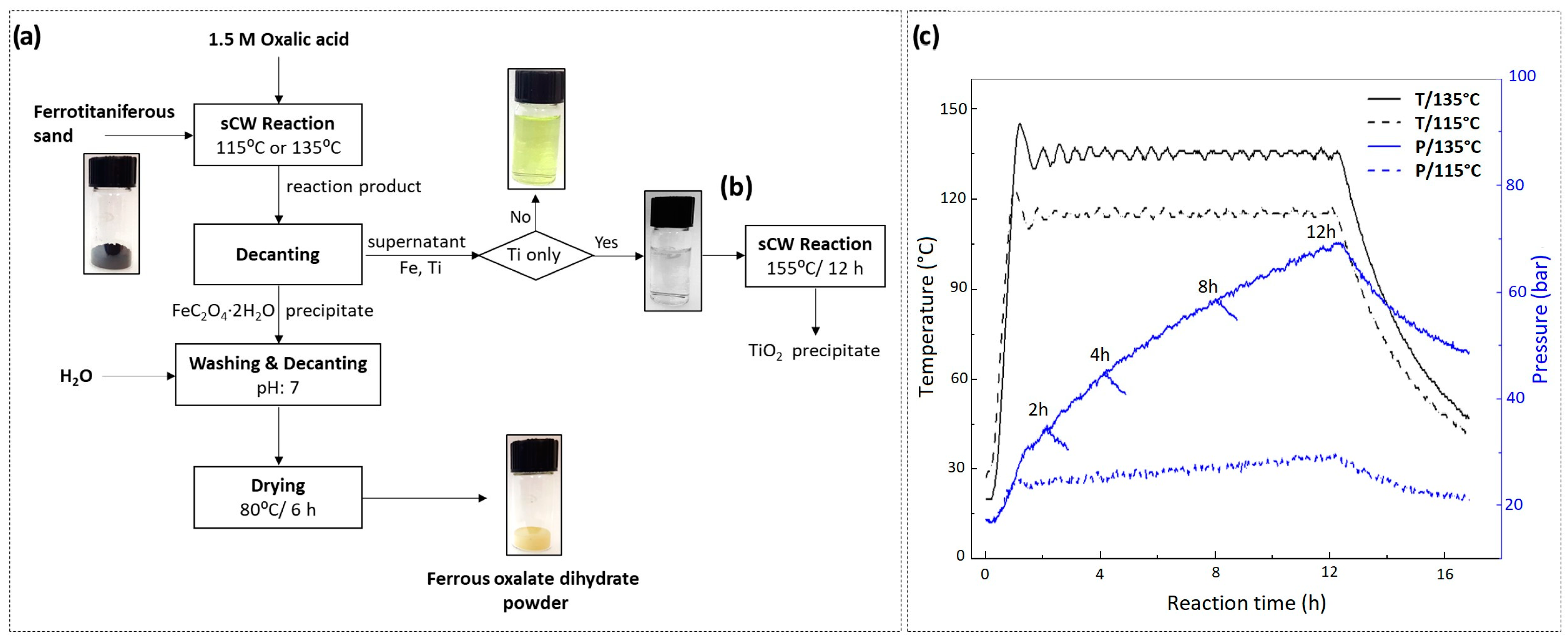


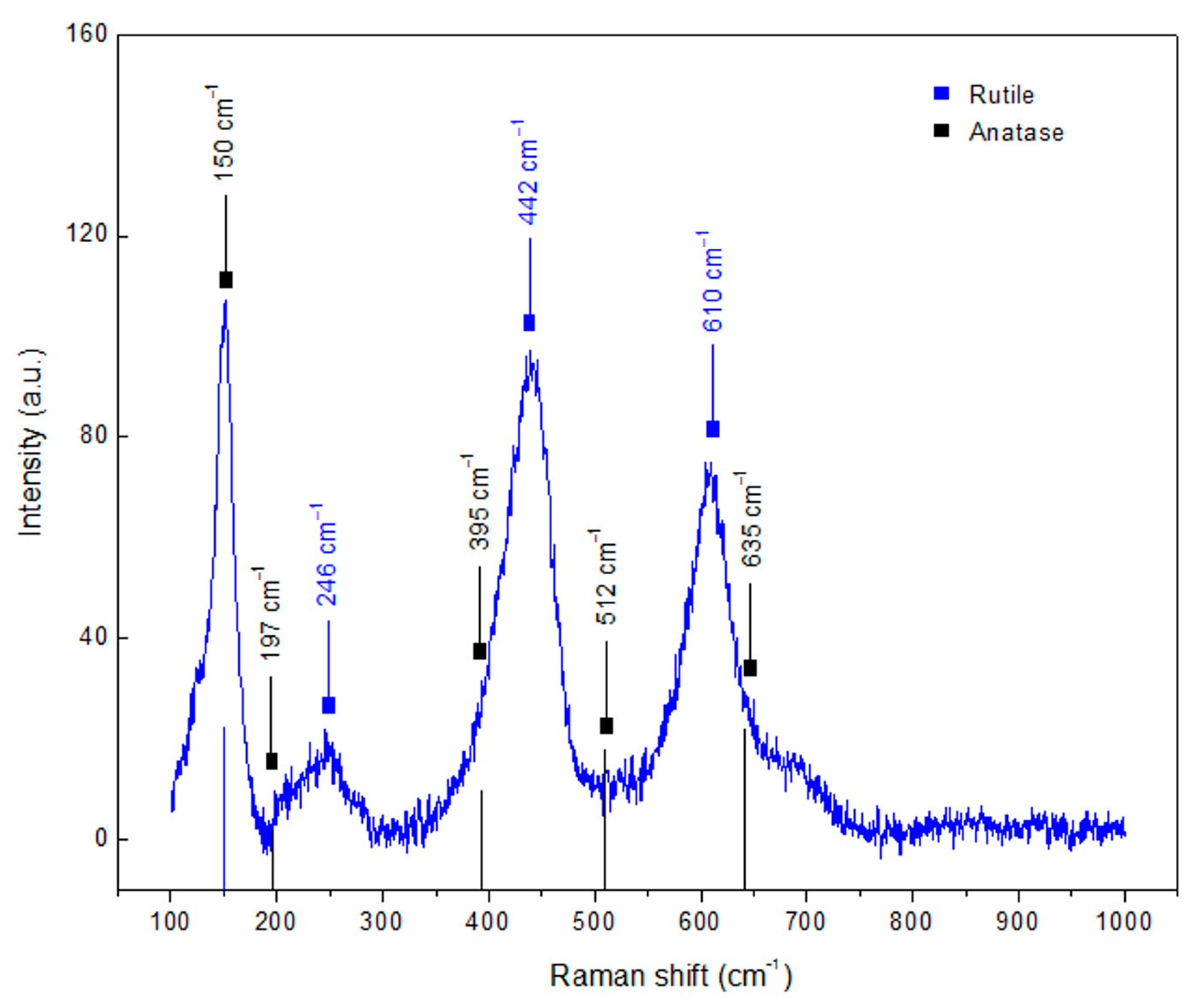
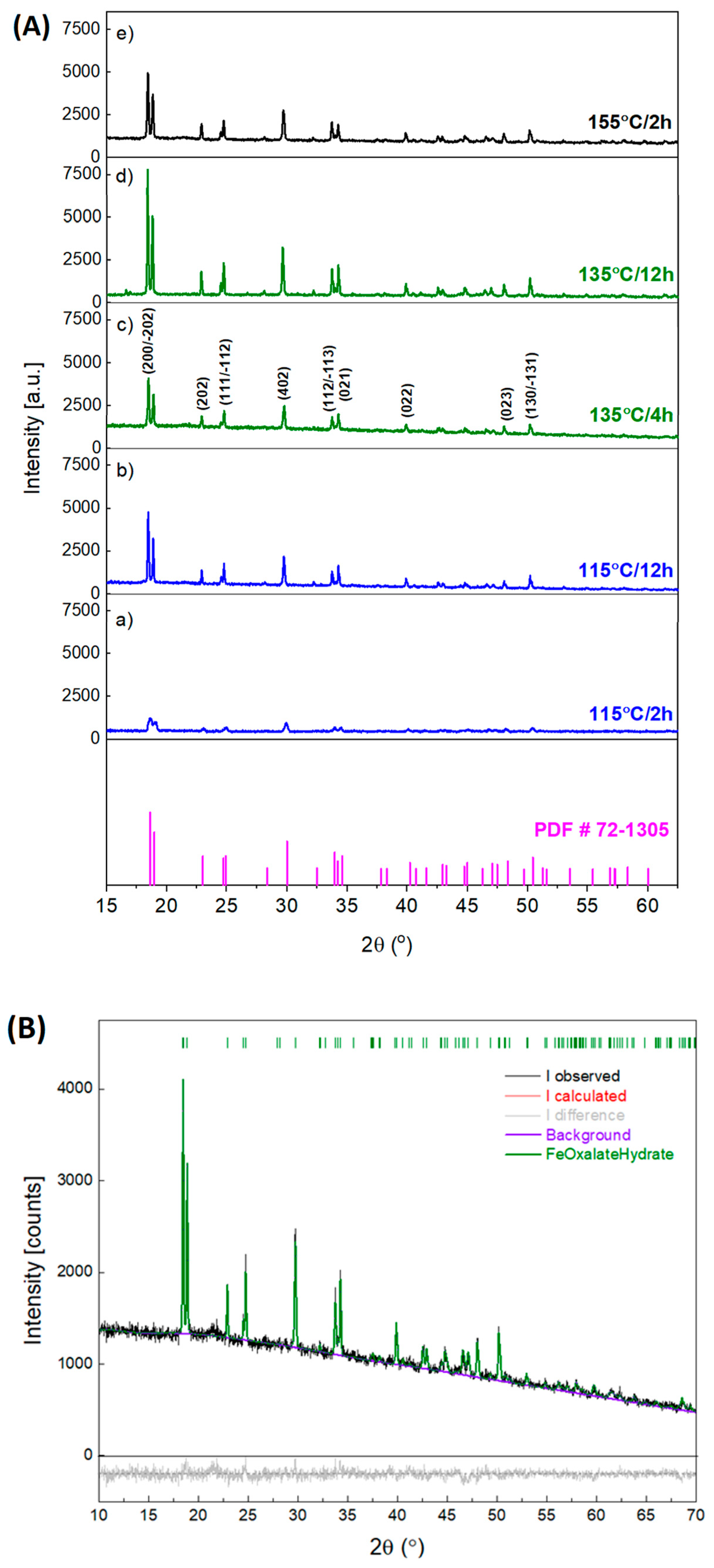
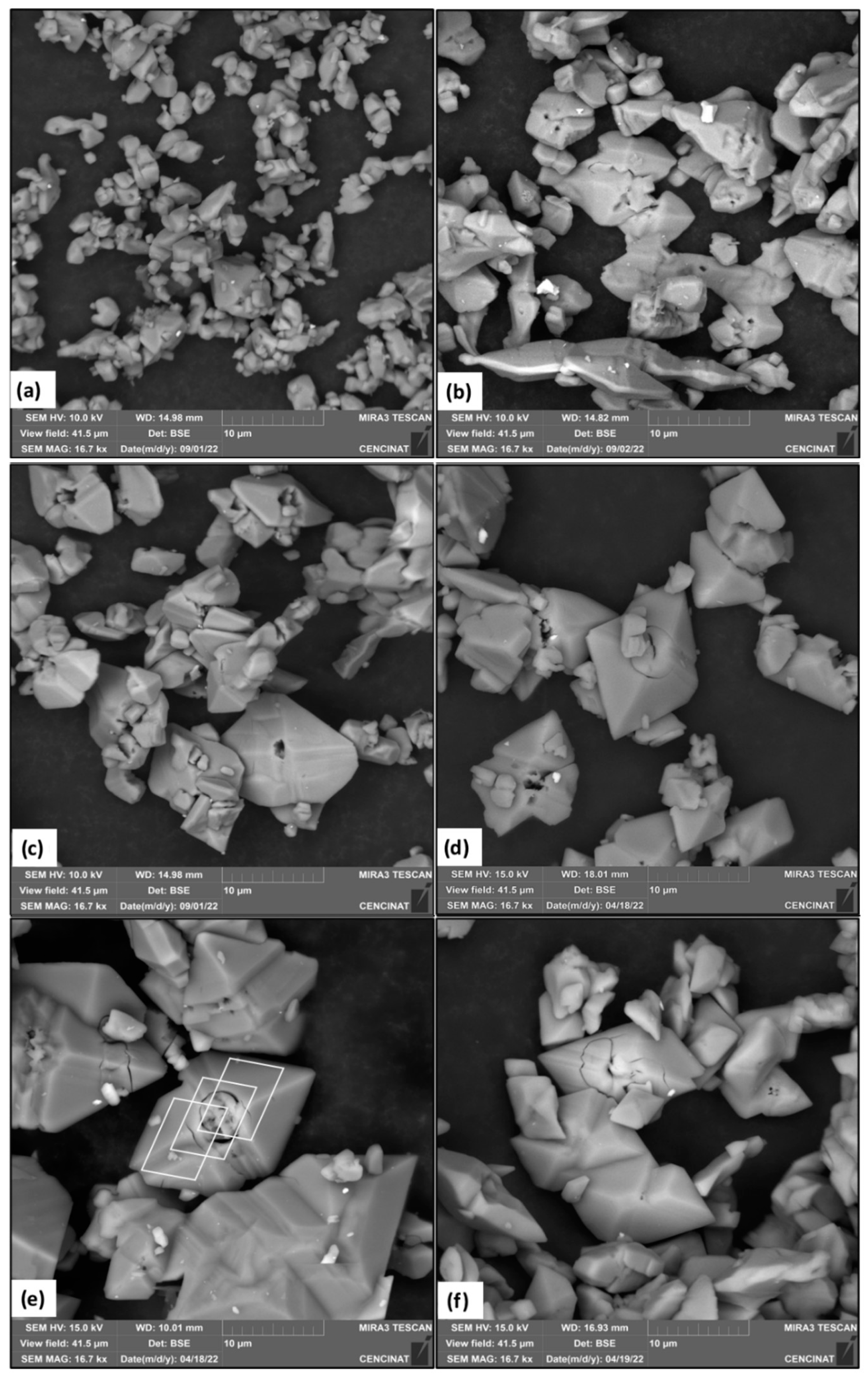

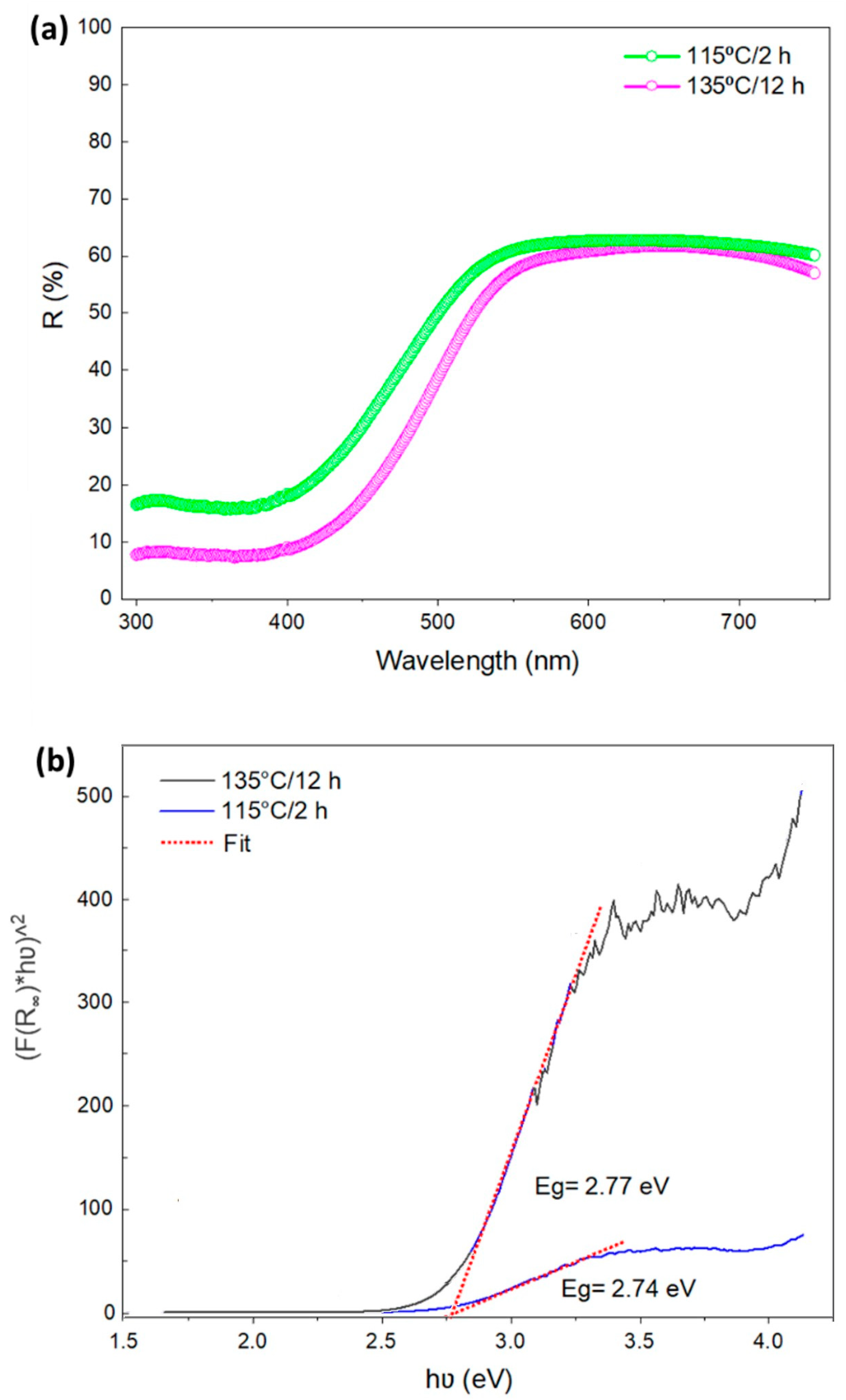
| T | k | A | Ea | |
|---|---|---|---|---|
| (°C) | (L∙mg−1·s−1) | R2 | (L∙mg−1·s−1) | (kJ∙mol−1) |
| 115 | 8 × 10−9 | 0.94 | 1.84 × 1012 | 151.52 |
| 135 | 8 × 10−8 | 0.99 |
Disclaimer/Publisher’s Note: The statements, opinions and data contained in all publications are solely those of the individual author(s) and contributor(s) and not of MDPI and/or the editor(s). MDPI and/or the editor(s) disclaim responsibility for any injury to people or property resulting from any ideas, methods, instructions or products referred to in the content. |
© 2024 by the authors. Licensee MDPI, Basel, Switzerland. This article is an open access article distributed under the terms and conditions of the Creative Commons Attribution (CC BY) license (https://creativecommons.org/licenses/by/4.0/).
Share and Cite
Valdivieso-Ramírez, C.S.; Galeas, S.; Saldaña, M.D.A.; Pontón, P.I.; Guerrero, V.H.; Vizuete, K.; Debut, A.; Marinkovic, B.A. Synthesis of Alpha Ferrous Oxalate Dihydrate from Ferrotitaniferous Mineral Sands via Hot Pressurized Aqueous Oxalic Acid: Kinetics and Characterization. Minerals 2024, 14, 891. https://doi.org/10.3390/min14090891
Valdivieso-Ramírez CS, Galeas S, Saldaña MDA, Pontón PI, Guerrero VH, Vizuete K, Debut A, Marinkovic BA. Synthesis of Alpha Ferrous Oxalate Dihydrate from Ferrotitaniferous Mineral Sands via Hot Pressurized Aqueous Oxalic Acid: Kinetics and Characterization. Minerals. 2024; 14(9):891. https://doi.org/10.3390/min14090891
Chicago/Turabian StyleValdivieso-Ramírez, Carla S., Salomé Galeas, Marleny D. A. Saldaña, Patricia I. Pontón, Víctor H. Guerrero, Karla Vizuete, Alexis Debut, and Bojan A. Marinkovic. 2024. "Synthesis of Alpha Ferrous Oxalate Dihydrate from Ferrotitaniferous Mineral Sands via Hot Pressurized Aqueous Oxalic Acid: Kinetics and Characterization" Minerals 14, no. 9: 891. https://doi.org/10.3390/min14090891
APA StyleValdivieso-Ramírez, C. S., Galeas, S., Saldaña, M. D. A., Pontón, P. I., Guerrero, V. H., Vizuete, K., Debut, A., & Marinkovic, B. A. (2024). Synthesis of Alpha Ferrous Oxalate Dihydrate from Ferrotitaniferous Mineral Sands via Hot Pressurized Aqueous Oxalic Acid: Kinetics and Characterization. Minerals, 14(9), 891. https://doi.org/10.3390/min14090891








